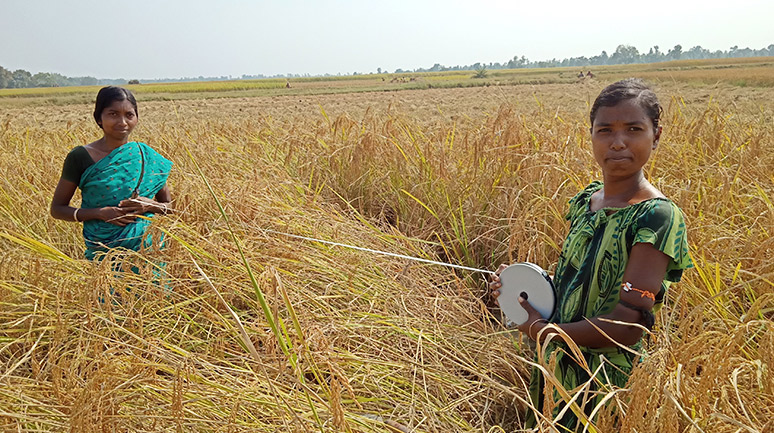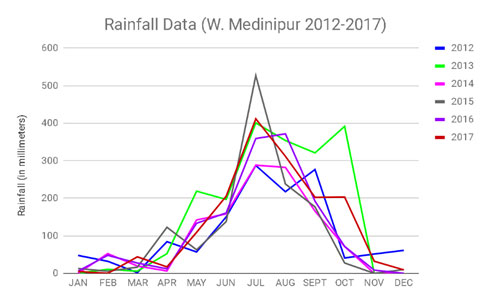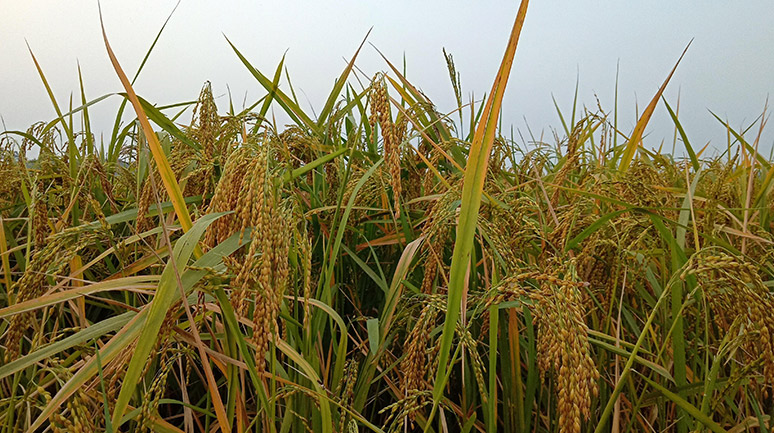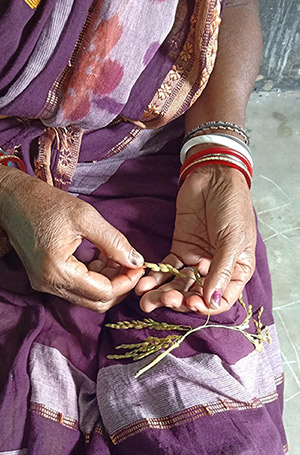The Taste of Desi: Scaling-up Livelihoods through Indigenous Paddy


In 2017, Phulkali Mahato, Anjali Murmu, Pramila Singh and many other women experimented with the indigenous paddy Kerala Sundari for the first time. Many of them chose to do so, based on the experiences of a few farmers in nearby villages in the past year. Phulkali’s experience was especially significant. Whereas many women experimented on tiny bits of land (rightly so because of the small size of land holdings), which were also mostly in the uplands, Phulkali grew Kerala Sundari in 0.5 acres of her best lowland. At the outset itself, her mother was against the idea saying, “Desi dhaan (indigenous paddy) will never give us good production; you’re going to waste the best land we have.” However, with the support of her husband, Phulkali went forward despite her mother’s apprehensions and objections. She reduced her seed rate and transplanted young saplings in an improved manner. She used no chemical fertilizers on her land and only treated the land with farmyard manure before ploughing. Despite the confidence with which she began, her confidence was decimated in the first week after transplantation. Every day she would call and cry and tell me about what one person or the other had said…all of it along the lines of, “You’ve gone mad, you’ll get nothing from that land;” “This paddy will never give you the kind of production that Swarna gives;” “Paddy is not cultivated in this manner;” and “You were a fool, you’ve lost your best land.”
In the monsoon of 2018, around 2500 farmers in Nayagram block of Jhargram district cultivated indigenous paddy organically on 300 ha of land. The average production, according to the data1 collected by PRADAN, shows an average yield of 4 MT/ha with the highest at 6 MT/ha. The experience is one in a long line of others that effectively busts the myth that organic methods result in reduced yield. In 2019, the PRADAN team increased this to 4000 farmers and 500 Ha of land.
Beginnings
Nayagram block in the newly created district of Jhargram in West Bengal. Located at the base of the Chhotanagpur Plateau in the Agro-Climatic Zone VII, it is characterised by red, lateritic soil. This area was historically part of the large swathe of dense forest dividing Bengal from Odisha and was so as recent as 40 years ago. Most settlers in the area migrated from one place or the other post the Santhal Rebellion and as such 47 per cent of the population belong to SC and ST communities. The people of the area have two primary sources of livelihood—agriculture and Non Timber Forest Produce (NTFP). The cultivation norm here is monsoon-dependent paddy. Despite receiving an average of 1000–1200 mm of rain every year, a sizeable portion of the lands remain fallow—a result of the undulating nature of the land, untimely rain, and sudden and extreme downpours causing soil erosion.
Dulki village, for example, has a perennial stream flowing through it and a large reservoir to its north. However, for women like Karmi Tudu, it means very little because all her land is in the uplands. “Every year, I sow the seeds hoping that it will rain and I will puddle my field and transplant my paddy. Most years, I don’t even manage to prepare the land. Last year (2017), the monsoon arrived in September. I transplanted whatever seedlings were in my seedbed hoping for a harvest. But there wasn’t enough rain towards the end and all I got was chaff.” This is the same experience of almost every farmer in the region, with the exception that widows such as Karmi are worse-hit, especially if they have no lowlands that will give them assured harvests. This is the same experience of every farmer in the region and women like Karmi are the worst hit as they have no lowlands to give them assured harvests in addition to being widowed.
PRADAN’s foray into indigenous and organic paddy, therefore, began as an experiment in response to two interlinked problems that were plaguing agriculture in the area—erratic rainfall and crop failure.
Primary among these was the erratic nature of rainfall, which resulted in crop failure on a massive scale for marginal farmers entirely dependent on rainfall. Erratic rainfall here means that rainfall is so irregular that a pattern cannot be drawn; this then makes it difficult to calibrate activities (of monsoon-dependent farming) such as sowing, transplanting and harvesting. For example, in 2016 and 2017, at the onset of monsoon in late June, farmers in Nayagram prepared seed beds for paddy. However, in the two weeks that followed, there was barely any rain and the land could not be prepared; the seedlings matured on the seedbeds, delaying transplantation and reducing yield and production. Similarly, in the summer of 2018, during the harvest of the paddy, heavy downpour caused severe losses of the paddy cut and laid down on the fields.
The rainfall chart for West Midnapore, where Nayagram is located, is shown alongside. As we can see from the chart, there is great variation in the amount of rainfall in a month for every year. This makes planning extremely prone to failure.
Additionally, it is the weekly distribution of rainfall that is most important in agriculture. Whereas the annual average or even the monthly average may be normal, a deficit in the week when transplantation needs to be done spells failure for the crop.

Figure 1: Rainfall in West Midnapore, where Nayagram is located
In 2018, the weekly distribution of rainfall was either in deficit or excess and rarely normal. In addition to this, erratic rains on the undulating land results in massive erosion of the top soil, thereby decreasing fertility, water-holding capacity and, ultimately, productivity. Water loss is quick due to the slope topography and leaves the uplands and the mid-uplands dry and difficult for a water-intensive crop such as paddy. The same uncertainty made it highly risky to cultivate crops that would fail in low-lying fields inundated with water. As a result of this, a significant amount of all cultivable land remained fallow even during the monsoon.
What could be done to increase land usage and intensity, and reduce input costs while being resilient to the vagaries of rainfall and climatic conditions? How could it be achieved without compromising on yield and production? These were the questions that the community was seeking answers for and that the team sought to address.
These questions led the team into a village called Pathorprotima in the Sundarbans, where a group of farmers as a part of the Save Our Rice Campaign were cultivating native paddy varieties to deal with the problem of salinity in their waters. They explained that indigenous varieties were extremely climate resilient, having tolerance for drought, flooding, salinity, acidity and so on. We were interested in the drought-resilient ones and needed paddy varieties that would have good yield in uplands in drought-like conditions.
Although finding a climate-resilient variety was the primary objective, production could not be compromised. With increasing populations and the shrinking size of landholdings, it is imperative for a marginal farmer to get high yield. We were introduced to Kerala Sundari and Bahurupi by the farmers in Pathorprotima but were warned, however, that the crop would fail if we used chemicals. This marked the beginning of our engagement with the indigenous and organic movement.
In our initial discussions about indigenous varieties, their extinction and the associated loss, the villagers spoke emphatically about the loss of control over production and their gradual but irrevocable losses resulting from the rejection of indigenous and the introduction of high yielding variety (HYV) seeds. Shyanmala Mahato says, “We keep the HYV seeds after harvest, but we are forced to get new seeds every three years. If we don’t, there won’t be anything to harvest at all. New HYV seeds yield the most produce. After the first year, however, the yield goes down till we change it all again. My father, who used indigenous seeds never bought any seeds in his lifetime and used the same seeds for years and years, and didn’t need any fertilizers at all.” Sujaya Mahato joins her saying, “With the HYV seeds, we have to use fertilizers and pesticides. Or else, we won’t get the harvest even with new seeds. There is no other way to do it.”
We invited the farmers from Pathorprotima to train the community on the preparation of organic inputs required for cultivating Kerala Sundari and other indigenous varieties.
In 2017, 380 farmers in five panchayats experimented with organic Kerala Sundari and saw inspiring success. In terms of yield, it was on par with the most common HYV in the area—the Swarna variety at 4 MT/ha (the country average is at 3.3 MT/ha whereas the average in Bengal is at 3.9 MT/ha). The input cost was one-tenth th the cost of chemical inputs at Rs 250/acre. To replace chemical fertilizers, farmers mostly took two paths: One, farmers increased their application of farmyard manure (cow dung) and, two, they prepared Jeevamrita (a concoction of fermented dung, cow urine, pulse flour, jaggery and termite soil). Kerala Sundari, being indigenous, meant it was hardier and more disease-and pest-resistant and, thereby, reducing the labour-cost involved in periodic pesticide sprays. Seeing all this, the team decided to make indigenous and organic farming the core of its programme.

Convincing the Farmers and Scaling-up
Before the success of the indigenous varieties, the whole team was erring on the side of caution and despite good experiences in using organic inputs, everyone was more than a little sceptical about the probability of its success in terms of yield. With the exceptional results of low pest-predation, significant reduction in input cost, and the high yield at 4 MT/ha, we were convinced beyond a measure of doubt about the suitability, effectivity and necessity of changing the agricultural paradigm from chemical agriculture to organic agriculture.
Our experience showed us that organic farming could be successful in all the above-mentioned nareas, without adding to drudgery. It also proved to us why organic methods elsewhere were either failing or failing to reach on par with chemical-based farming. The key we had been told were the seeds—and this was our experience as well. Organic inputs would not be effective for crops designed to uptake nutrients in particular forms and means, meaning that HYV or Hybrid seeds would not fare well in an organic environment. We saw this happen to the Swarna variety when done organically and also to the hybrid oilseeds, which gave less than the standard production.
Additionally, due to the presence of large tracts of forests in Nayagram, there is nutrient replenishment for the soil in the form of siltation from the forest to the cultivated lands, which is a blessing that completely flat lands don’t have.
We realized that to make organic farming a success, it was essential to move to indigenous seeds, and for all of it to succeed, it had to be scaled up massively. As such, the team went to work on making this happen. For the first step, we had concept seeding meetings at the sub-cluster level with each SHG in the outreach area. We then ran the agricultural politics training module for training each member of the SHG groups. The module helped farmer participants to locate themselves in relation to the external forces that determined their livelihoods. For the training, we created two videos—one, documenting the experiences and impressions of the women, who had experimented with organic farming in 2017, and the second, a short skit on agricultural politics in the country and the scope for indigenous farming in the area. A booklet on organic inputs and the preparation (production process) of these was designed for the purposes of organic trainings, which were carried out in all the villages and with all the groups. We also planned to carry out a mass dissemination through loudspeaker coverage and video shows in villages, to include members of the community outside the SHGs as well as in areas where the team was not operating.
Also, strategically, in the first year, the team experimented in each village with five women farmers to create a ready exposure ground for others in the village. SHGs organised into a larger body of a village-level organisation (VLO) colloquially known as sub-cluster, or upa-sangha, undertook the task of mobilizing their members around the same, by planning for and generating the indent (A list with data on what each farmer intends to cultivate and how much land for each variety of indigenous paddy. This is so that we can calculate the quantity of seeds required, the number of trainings to be planned, etc). All these initiatives built on the existing, unarticulated sentiment among women about chemical-based agriculture and the general decline in well-being and health, despite seeming prosperity. Swarnaprabha Mohanta illustrates this saying, Didi, nowadays, everyone has gas (flatulence). Even infants have to be given gas medication. Almost every house in our village has a sugar (diabetic) patient.”
Despite the targeted approach and strategies, it was difficult to turn people to what is called ‘desi’. Indigenous rice has been so maligned that people just would not believe that a ‘desi’ paddy could yield as much as we were claiming. There was the additional problem of ‘desi’ paddy stalks being too long and often falling into the water with the strong winds, which further lowered yield and made people wary. Kerala Sundari, being a mid-duration (135 days), drought-resistant variety with hardened stalks, was ideal for the mid-uplands, which more often than not remained fallow or saw crop failure as a result of water unavailability. The crop would not fall down and would also flourish in drought-like conditions. Another big block to overcome was the idea that organic manure could replace chemical fertilizers; it was helped by the traditional knowledge that desi rice does well with organic manure and poorly with chemicals.
Yet another challenge, apart from the work on changing the perception about indigenous seeds, was the procurement of the seeds itself—both in the first year of experimentation as well as the second- year. Our search for seeds brought us in contact with Dr. Anupam Pal, who has been quietly leading the indigenous movement in Bengal for the past few years. Dr. Pal is the Deputy Director of Agriculture at the Agriculture Training Centre at Nadia under the West Bengal government and also a passionate advocate of the organic and indigenous movement in the state and in the country. With a significant amount of help from Dr. Pal, we managed to source our seeds from five different places—Cooch Behar, Bankura, Bardhaman, Haskhali and farmers’ experimental fields.
What Does the Intervention Address?
In Nayagram, women, in addition to all the unpaid productive and reproductive work, also contribute significantly to the family cash income through the collection and sale of NTFP products such as sal leaves, mahua flowers and babui ropes as well as seasonal migration as agricultural labour. The reduction in productivity has meant an increasing pressure on women to generate more cash income from these NTFP sources as well as to intensify migration. As such, one of the primary motives in looking for climate-resilient paddy varieties was to increase agricultural productivity that would result in a reduction of the pressure on women. Similarly, the increase in input cost in chemical-based production also creates similar pressures on women; therefore, reducing input costs would also similarly benefit women.
The cost of chemical-based agriculture is unsustainable as the continuing damage to the soil reduces the biomass in the soil and necessitates increased usage, resulting in further damage; the cycle goes on till the land is unusable as has been demonstrated in Punjab and Haryana. In one of the meetings, Basonti Soren of Bhaliaghati village pointed out the effect of fertilizer use saying, “The soil has become harder and harder with each year. And because it has become harder, we have to use more fertilizer. We can’t plough these lands in the summer because it becomes like cement.” Rekha Sing adds, “There aren’t any earthworms in our fields anymore because of all the fertilizers and pesticides.” The impact on health and the documented increase in health expenditure in rural areas are directly linked to the increase in consumption of insecticides and pesticides, used in growing food. A portion of this ecosystem includes fish, crabs and clams, with which farmers used to supplement their food-basket during the lean dry months; these are no longer available, making the farmers poorer nutritionally and ever-dependent on cash income, to replenish these resources.

PRADAN@work in the past two years has made people, and especially women, central to the whole intervention. This has been possible because of the kind of mobilization that PRADAN has generated through SHGs and related institution-building activities. The kind of trust and relationship fostered between those working in the field and the communities, as a result of the continual engagement with not only the women but also other elements within the villages, has further helped reach out to those beyond SHGs, to achieve the kind of scale and make a paradigm shift.
PRADAN’s experiments with the women of Nayagram have shown that organic farming can be successful and that indigenous seeds are key to the entire enterprise of ecosystem rejuvenation, sovereignty of farmers, and food safety and nutrition. What needs to hold it all together is the immediate and real world need of the farmer for income and savings. Without addressing the farmer’s daily requirements of cash for even minimal expenditure on food (vegetables, oils and spices are mostly bought and even the food in the PDS is not free), school and education (as a result of the failure of our schools, parents pay tutors outside of school), transport costs (as small as cycle maintainance), rituals and customs (deaths, births, marriages), health, etc. it is not possible to address larger issues of the ecosystem and climate change. If and only if these survival costs are met, the farmer can move to a system that is less exploitative or else she will continue with the system that ensures her survival in the short term.
1 The Yield or Production data is collected by taking five squares of 1 metre each in the four corners of a plot and the centre. The harvest within the 1 sq.m is then cut. All five portions are then threshed and weighed from which the yield is estimated.
Source - https://www.theweek.in/webworld/features/lifestyle/Climate-change-cause-of-erratic-rains-in-
india.html
https://www.outlookindia.com/newsscroll/lower-monsoon-erratic-rains-to-affect-farm-sector/1508746


5 Comments
This needs to be edited Vineeta -_-
Excellent
Great success story. Congrats. Changing mindset is a key challenge and you succeeded. Nothing succeeds like success. I am curious to know how they are processing the paddy into rice? The usual commercial process would perhaps rob all the natural goodness out of it. I am convinced there is a market for rice processed out of the old traditional method of “dheki chhata chaal”.
The paddy is processed in a rubber huller which are specifically designed to keep the bran intact. So with it, we get 100% bran retention. It’s an upgrade from ‘dheki chhata chal’ in that it reduces manual labour while still retaining the natural goodness of rice.
Straight to the point and well written, thank you for the information